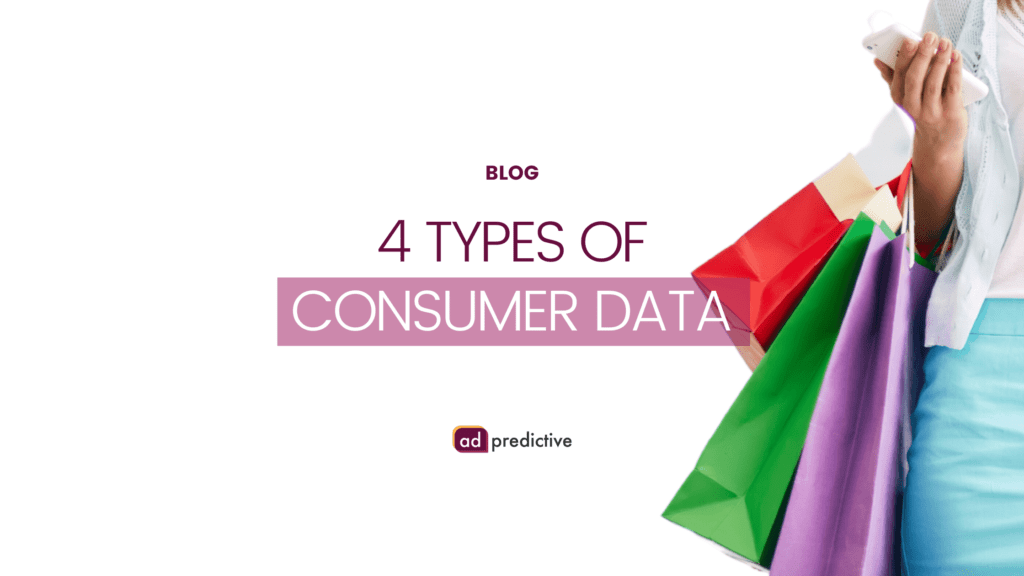4 Types of Consumer Data Empowering Marketers

In the world of modern marketing, consumer data has become a crucial component for brands aiming to thrive. An abundance of consumer data is constantly being generated – offering a wealth of valuable insights into consumer behavior, preferences, and trends. Let’s explore the four types of consumer data and how you can use it with customer intelligence to stand out amidst the noise.

Basic Demographic Data for Precise Segmentation
Get to know your customers on a foundational level by observing demographics. Basic demographic data identifies customer age, gender, income, education, life stage, and more. By analyzing demographics and other basic data factors, you can segment your customer base effectively. With AdPredictive’s Intelligence Solutions, you can cross basic data with attitudinal data to uncover deeper insights. For instance, you can identify specific preferences within each demographic group, tailoring messaging to align with diverse customer needs.
Example:
A car dealer can utilize demographic data to target audiences of a certain age and income range likely to purchase a vehicle. They can further refine that targeting by location to ensure efficiency in reaching an audience that is likely to visit their dealership. Creating personalized content catered to this demographic definition will help to drive conversion on the lot.
In addition to leveraging demographic data for targeting potential car buyers, dealers can enhance their marketing strategies by focusing on vehicle features that resonate with their audience. One such feature is the quality and customization of car seats. Personalized content highlighting premium options for car seats can capture the interest of customers who prioritize comfort and style. For instance, Seat Covers Unlimited offers a wide range of custom seat covers that cater to different preferences, helping dealers address the specific needs of their target demographic. This approach can significantly boost engagement and conversion rates, as customers are more likely to be drawn to a dealership that addresses both their functional needs and personal preferences.
Behavioral Data for Tailored Recommendations
Uncover behavioral patterns that illuminate your customers’ interests and preferences related to your brand. Behavioral data – specifically when incorporating behavioral data from the industry’s leading 3rd-party data providers – reveals trends in your customers engagements, interests and preferences. When applied to your brand, behavioral data illuminates attributes that can refine a clear niche for high-impact targeting.
Example:
An entertainment company can use behavioral data to uncover TV viewing and streaming habits among their reached audience. This insight can be used to align audiences with new programming that is likely to be of interest alongside advertising that is likely to convert.
Attitudinal for Emotionally Resonant Messaging
Discover what’s in the hearts and minds of your customers with attitudinal data. Understand their opinion of your product, sentiment, and motivations – then use that insight to craft emotionally resonant marketing messages. You can create connections with your audience that transcend transactions, driving brand loyalty and advocacy.
Example:
A travel company can tap into customer survey and emotional response data to craft marketing campaigns tailored to thrill-seeking customers. By highlighting experiences that align with their customers’ desired hobbies – like zip-lining through lush jungles or exploring exotic destinations – the travel company creates an emotional bond that inspires bookings and loyalty.
Interaction Data for Enhanced Customer Experiences
Gain valuable insights from your consumer website visits, sign-ups, social media likes, clicks, purchases, on-site visits and more. Customer interactions can have significant impact on creating efficiency and effectiveness in your targeting. Armed with interaction and conversion insights, you can offer personalized recommendations, promotions and other content design specifically to convert or affect other processes within the business.
Example:
A technology company can leverage interaction data to improve its online customer experience. By analyzing click paths and high-traffic areas, they can identify potential pain points and areas where the experience can be enhanced. Implementing customer-centric improvements based on this data boosts customer satisfaction, can improve conversions and showcases the brand’s commitment to its customers.
In the era of data-driven marketing, these four types of consumer data contribute heavily to guiding brands toward successful engagement of their customers. By leveraging your customers’ demographic, behavioral, attitudinal, and interaction data with AdPredictive’s Customer Intelligence Solutions, marketers can supercharge their data-driven strategies and create impactful marketing campaigns that resonate with their audience on a profound level.
12 thoughts on “4 Types of Consumer Data Empowering Marketers”
Comments are closed.